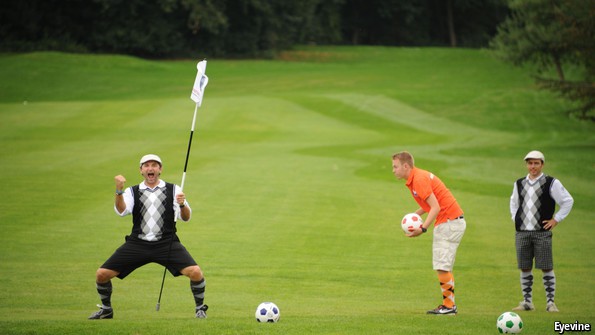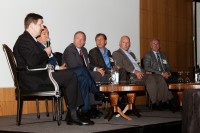
Though thriving in parts of Asia, golf is struggling in America and much of Europe, and is trying to reinvent itself for a generation brought up on the quick hits of video games
ON A recent Saturday Matt Owens, the owner of Trenton Street Golf Course in West Monroe, sat indoors facing the entrance to his course and greeted golfers. In this town of 13,000 inhabitants with a love of fried catfish and a reverence for “Duck Dynasty”, a television show about hunters whose stars live nearby, golf used to be a regular indulgence for many, and that mild autumn weekend was ideal golf weather. Yet by the end of the afternoon Mr Owens had taken in only around $200 in green fees, a tenth of what his course earned on Saturdays a few years ago.
On weekends Mr Owens’s 12-year-old course once swelled with golfers, but that ended when the economy sliced into the rough in 2008. He offers prices “affordable for rednecks”, but bargains are not enough to bring back customers. “I sometimes believe that I could give golf away, and they still wouldn’t come,” he says. At the end of December he will close the course, and it will become a public park.
Teetotallers
Golf traces its modern origins to 15th-century Scotland, where people played with wooden clubs and balls full of feathers. In 1457 King James II temporarily banned it, along with football, because it interfered with archery practice, but he was no match for its growing popularity. Mary, Queen of Scots was an enthusiast; her clubs were carried by students she called “cadets” (now known as “caddies”). The game of “gawf”, as it was first called, spread: first to England, and subsequently to its colonies.
Golf went mainstream in America in the 1890s. The wealthy and upper middle classes formed private golf clubs where they could play. Then, as today, its appeal depended on time and money. Late-19th-century Americans, with plenty of both and no gadgets to occupy them at home, liked the fact that it took hours to play. Safer than polo and less tiring than football, golf allowed businessmen to get to know each other and do deals between shots. John Rockefeller and Andrew Carnegie, early adopters, helped make the sport fashionable.
It builds character as well as relationships. Golf teaches honesty, patience and camaraderie. Players see how their peers handle failure. The mental focus golf requires, with its excruciatingly difficult odds, keeps enthusiasts both attracted to and humbled by the game. P.G. Wodehouse once observed, “To find out a man’s true character, play golf with him.”
As America prospered, public courses opened alongside private clubs and exposed more people to the sport. Real estate helped drive its rise. Between 1992 and 2002, at least 60% of new golf courses were tied to property developments, according to Richard J. Moss, author of “The Kingdom of Golf in America”, a rich history of the sport. Golf courses increased the value of surrounding homes, and developers built long, complicated courses with the hope of attracting tournaments and attention.
Today America is the largest golf market by a long shot. Around half the world’s golf courses and players are thought to be in America, and the sport contributes around $70 billion to America’s economy according to a 2011 study. Golf is not unlike a first home or a college degree: it carries the allure of progress, of arrival in the middle class. Only a few years ago some golf gurus forecast that the sport would grow even more, as baby boomers retired and flocked to the fairways.
They were wrong. Last year around 25m people played golf, 18% fewer than did so in 2006, although the population grew by 6%. Although still played by men and women, including businesspeople hoping to bond over more than lunch, golf does not hold the same appeal for the young and minorities, groups that will determine its future health. In recent years more people have abandoned than taken up the game.
Emerald courses have not been the source of riches many anticipated. There are simply too many of them. Last year 160 of the country’s 14,600 18-hole equivalent golf facilities shut up shop, the eighth straight year of net closures, according to the National Golf Foundation, an industry group. Steve Skinner of Kemper Sports, a large golf-course operator, thinks it is going to take another ten years to level the imbalance between supply and demand. With only a handful of new courses scheduled for construction in America, architects are looking abroad to find work. “If golf-course architecture were a publicly traded stock, it would be a penny stock right now,” says Brian Curley, an architect who spends much of his time designing courses in China.
Professional golf remains healthy, as sponsors and advertisers still seek the wealthy, older men who form the core group of golf viewers and players, and consider them worth reaching, even in dwindling numbers. But sellers of golf clothing and equipment have been squeezed. Earlier this year Dick’s Sporting Goods, a national retailer, laid off hundreds of employees in its golf division. Nike and Adidas are among the sports manufacturers that have seen their earnings hit by a slowdown in recreational golf. Television ratings for golf on television have also declined.
Eastern promise
In some markets outside America, golf is on the rise. In China, where Mao Zedong banned golf in 1949 and building new private courses is illegal, it is still booming. According to Dan Washburn, author of “The Forbidden Game”, plenty of courses are built under the guise of adding “green space” and “ecotourism zones”, but a recent crackdown by the central government on corruption has slowed new course development. The party is not over, says Mr Curley, the architect, “but all the lights are on and the cops are out at the curb”.

Yet in most mature markets, such as Australia, Japan, England, Ireland and even Scotland, golf is struggling. In England, for instance, the number of people playing golf at least once a month has declined by more than a quarter since 2007 and golf-club membership is down. In Australia club membership has fallen by a fifth since its peak in 1998. In Japan golf participation is down more than 40% from its high in the early 1990s, although numbers have stabilised in recent years. There are some green shoots: in the Czech Republic golf is growing, as it is in Germany. But these markets are a small fraction of the size of America’s.
To some extent, golf’s appeal has become its undoing. Its calm, meditative quality does not suit the frenetic pace of modern life. Playing 18 holes, the game’s standard, takes four and a half hours or more, not counting commuting or lunch. Time-starved Americans rarely devote so many hours to anything—other than, perhaps, a transcontinental flight and sleep.
Golf is a hard sport to master. In 1914 Woodrow Wilson spoke for many frustrated golfers when he described the game as “an ineffectual attempt to put an elusive ball into an obscure hole with implements ill-adapted to the purpose”. Robert O’Neill, the Navy Seal who shot Osama bin Laden, was urged by his psychologist to take up golf, but found it “more stressful than combat”. Nor can it be neglected for some time and picked up again with ease, like skiing or tennis. Its rule-book is some 200 pages long, too big to tote around in a golf bag. “Golf is my life, but I’m still learning new rules every time I play,” says Charles Grace, who works on Wall Street and has been a golfer for 13 years.
And golf has been getting even harder. During the 1990s and early 2000s professional golfers were getting better and innovations in equipment enabled them to hit balls farther so developers competed against each other to build more challenging, longer courses, full of hazards. But the longer, harder courses favoured strong, male golfers and became more challenging and time-consuming for the average player. Golf’s ranks were expected to swell when baby-boomers retired, but many of them have found the arduous courses too much like hard work.
When a star comes along, the game can suddenly enjoy an unexpected boost. In 1913 Francis Ouimet, a former caddy, won the US Open golf at the age of 20. His photo on the front pages of newspapers raised awareness about the sport. About a decade ago the rise of a pretty female golfer, Ai Miyazato, encouraged a wave of young Japanese women to try amateur golf. But no star has been a more powerful draw to new players than Tiger Woods. When Mr Woods, arguably the best golfer of all time, started winning championships in the late 1990s, people who had previously thought of golf as playtime for rich, white men stepped onto the tee.
Unfortunately, stars’ wobbles can hurt the sport as much as their superb swings can help it. In 2009 the “Tiger bubble” burst when it became known that Mr Woods was behaving badly off the course. He then started to play badly on it. Professional golf is still a healthy business, but nobody has succeeded in replacing Mr Woods’s broad appeal. Having Barack Obama as America’s “golfer-in-chief” has not drawn new fans to the sport. This month’s cover of Golf Digest features Johnny Manziel, a well-known American football player. He has little connection to the sport, but is better known in America than most professional golfers.
Putter up, buttercup
Golf has more than itself to blame for its challenges. Its decline is due in part to something even the most meticulous golfer cannot control: the economy. Paying to spend hours getting a white ball into tiny holes with as few strokes as possible becomes harder to justify during times of economic hardship. In 2008 golf participation and spending slid at private clubs and public courses alike.
Since the economy has picked up, benefiting the rich more than the poor, high-end courses in good locations have been doing well, according to Donald Trump, who owns 18 of them. People earning $100,000 or more now make up 45% of all golfers, up from 40% in 2005, according to KeyBanc Capital Markets. The middle and lower classes have been squeezed, which hurts mid-range golf courses and those in sparsely populated areas. Many municipal golf courses have closed, because governments are unable to justify support for golf when they have cut spending on education and social services.
Society today is not as friendly to golf as it once was. Men who disappear on Saturdays and palm off child-rearing to their wives have more to worry about than a high handicap. Some clever golf gluttons have tried to interest their kids in golf, in order to justify a weekend round while still getting parental points, but fathers these days are more likely to be taking their children to various sporting activities than taking part in their own. Mr Owens at the Trenton Street Golf Course thinks that the high rate of divorce across America also keeps men from golf, because weekends are when they get to see the children.
Bringing in and retaining players below the age of 45 is more difficult than at any time in living memory. Millennials in America expect, if not instant gratification, at least near-term rewards. Golf’s pay-offs can feel elusive. Dan Wald of the Boston Consulting Group, who advises sports businesses, says that golf video games actually decrease the chance of getting a young person to play golf, because hitting a ball smoothly down a real fairway is so much harder than on a virtual one. Golf has more competition for people’s leisure time than ever before.
Golf is an old-fashioned sport, obsessed with tradition. People still dress up as though they are auditioning to star in “Caddyshack”, a 1980 comedy about a stuffy country club. Private golf clubs have not helped their cause by banning mobile devices and enforcing etiquette. One young female golfer complains of being scolded for wearing a tennis skirt when she played golf at an elite club, even though it met length requirements.
The game’s long history adds to its charm, but has sometimes damaged its image. The sport has had a particularly uneasy relationship with women and minorities. One all-male golf club in Scotland had, until a few years ago, a sign hanging outside saying, “no dogs, no women”. (Some members objected to dogs not being allowed in, quips one insider.) The Royal and Ancient Golf Club of St Andrews in Scotland, a club founded in 1754 that supervises the game’s rules, voted to admit women only in September 2014. America and golf used both to be racially segregated, but attitudes and demographics have changed faster in the nation as a whole than in the sport.
Golf is not alone in struggling to appeal to the young. Participation among young people in many sports is down. Hunting, for example, has declined in popularity. Like golf, it is slow; unlike golf, it involves more real blood than some young people want to see. Those who play sports are specialising earlier, which disadvantages golf, where only the most elite schools have teams.
A stunning 80m Americans take part in no sport at all. But those who get off their couch often prefer a rigorous workout, which explains the rise of triathlons, kitesurfing and other activities that leave participants breathless. The tech folk in Silicon Valley have their own athletic customs, such as cycling. Because golf courses have become so long, many golfers tootle around in carts without getting much exercise, rather defeating one of the points of sport.
Putting genes
The golfing establishment knows it needs to attract new people into the game, says a former board member of the United States Golf Association (USGA), golf’s rules-making body in America, “but there’s dissent on what the real problem is and who should solve it”. Three groups, whose priorities are not always aligned, oversee various aspects of golf in America. “There’s no other sport that has as fragmented a governance structure,” says Rohan Sajdeh, a partner at Boston Consulting Group.
Golf is one of the few sports where amateurs can play the same game, with the same rules, as professionals. The system of “handicaps” enables a tiger cub to compete against Tiger Woods. But there is a need to lighten the sport’s orthodoxy in order to make it more appealing to modern lifestyles. One relatively uncontroversial strategy is to encourage people to play nine holes instead of 18, which can help attract women and young people seeking swifter versions of the game. In Japan, “lonely golf”, in which older people show up by themselves in the hope of playing with someone for a round, has become more common as the population ages. In South Korea “screen golf”, in which people play in golf simulators, is an especially popular activity and corporate outing, but golf snobs do not regard it as the real thing.
In America courses are experimenting with “footgolf”, which involves kicking a football on a golf course into 18 enormous holes. It is fast-paced and attracts younger players. Some think adding 15-inch cups on golf courses could make the game more manageable for novices, but experienced players worry about courses being dumbed down. “We have to become a little more accepting of what it means to have a golf experience,” admits Pete Bevacqua, the boss of America’s Professional Golfers Association.

Courses like St Andrews in New York state, the oldest golf club in America, are investing in practice facilities, including hitting bays and simulators, so people can “golf” without playing a traditional game. Private clubs have tried to lighten up in order to appeal to the young, cutting down on the amount of space they reserve for formal dining and adding more family activities. Recently a few desperate clubs have even put aside their denimphobia and started admitting people wearing jeans. Golf needs to allow for a bit more spontaneity. If friends want to play basketball, they do not have to hire a referee and play four quarters for it to count as such, observes Mr Bevacqua.
Your correspondent set off to visit a site on the outskirts of Dallas that many in the golfing establishment regard as a model for the sport’s salvation. “TopGolf” looks like a cross between an outdoor bowling alley and sports bar. People show up in groups or on dates for food and drinks and to try their luck hitting white golf balls with sensors into huge, coloured holes that act as targets on a green. The technology can tell whether the ball makes it in, and awards them points when they do.
Customers often wait hours on weekends for their group’s turn at the novel game. In the meantime they can go to the rooftop bar while they wait and drink beer and cocktails, or play pool or video games. Ken May, the boss of TopGolf, says that the concept solves golf’s three main problems: it is affordable, unstuffy and fun. “There are a lot of beautiful people here,” he effuses: not golf’s typical pitch. The business is growing fast: some 4m people, most of them under the age of 40, will try TopGolf this year at one of its 15 locations in America and Britain. Golf pros are gearing up to wander around locations and show players how easy “real” golf can be. This modern offshoot, however, is more likely be a good business itself than a feeding ground for recruits. Few bowlers, after visiting a bowling alley, decide to take up the game with gusto.
Others have their eye on another recruitment tool. In 2016 golf will re-enter the Olympics in Rio de Janeiro for the first time in 112 years, which will raise its profile internationally. People who have never watched golf on television will be exposed to it for the first time. Leaders of America’s golf establishment hope the Olympics will persuade new players in Latin America and Asia to try the sport that swept their own country over a century ago. Some undoubtedly will. But the odds of Americans flooding back to the sport are about as long as those on a small, white, indented ball flying down from tee to hole in a single stroke.





